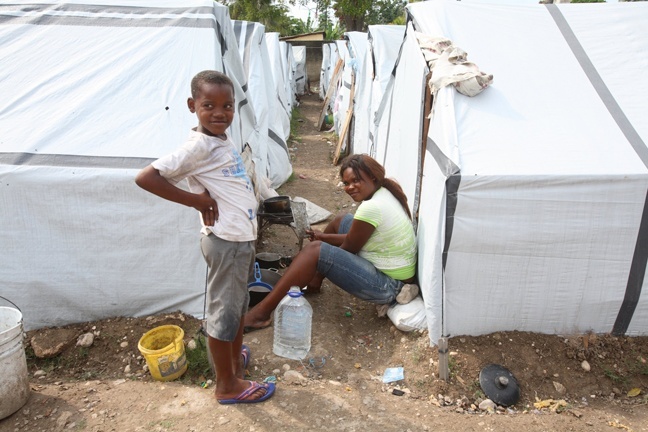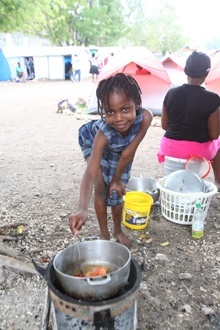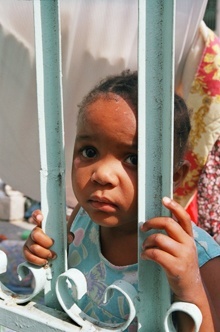By Tom Tracy - Florida Catholic

Photographer: TOM TRACY | FC
Child earthquake refugees pose for the camera at a tent city in Port-au-Prince.
MIAMI � Efforts to find interim shelter for Haiti�s homeless populations and local clergy and religious following the Jan. 12 earthquake remain the major aim of Church recovery there as the hurricane season gets underway.
In Miami for the installation Mass of Archbishop Thomas Wenski, several members of the Haitian episcopate as well as the papal nuncio to Haiti and the director of the U.S Bishops� Office for Latin American Affairs spoke with the Florida Catholic about the recovery efforts a half-year after the historic catastrophe.
�We met with the president (of Haiti) just a few days ago and his main preoccupation is the people under the tents as a bad hurricane season has already been predicted,� said Bishop Joseph Lafontant, apostolic administrator of Port-au-Prince. �The Church doesn�t have the facilities to help them all in that way.�
�In the provinces we can get some materials together and provisional shelters that will help, but people are taking advantage of the situation by selling materials at increased prices,� Bishop Lafontant added. �Many of the rectories have collapsed and clergy have no shelter, so we are working on this urgently with Catholic Relief Services.�
His comments came a day after a June 1 meeting in Miami of the Haiti bishops and the Haiti Advisory Group of the U.S. bishops� Subcommittee on the Church in Latin America. The meeting was held the same morning as Archbishop Wenski�s installation and attended by Boston Cardinal Sean O�Malley, Brooklyn Auxiliary Bishop Guy A. Sansaric and many of Haiti�s bishops.
Participants reviewed the initial findings and recommendations of a Haiti Site Assessment report compiled in part by Archbishop Wenski, who traveled to Haiti in April but who was unable to attend the meeting as he prepared for his installation. Oblate Missionary Father Andrew Small, director of the U.S. Bishops� Office for Latin America, briefed the committed on the findings.
�We are talking to the Haitians about setting up a foundation through which to run the projects and have very clear protocols about how we do distribute funds to make sure that it is to standards that we want carried out,� Father Small said.
He added that a substantial amount of emergency funds has already been spent following the earthquake but that the majority of the donations toward ecclesial rebuilding have yet to be used.
�TOTALLY CHAOTIC�
In addition to making long-range plans to get Catholic life back to some sense of normalcy, it is the interim recovery and shelter-related efforts in Haiti that need urgent attention and greater emphasis, according to Archbishop Bernardito Auza, papal nuncio to Haiti.

Photographer: TOM TRACY | FC
A child cooks a meal at an earthquake refugee tent city in Port-au-Prince.
�There needs to be more transitional housing solutions for the homeless,� Archbishop Auza said. �People from the provinces who were not really affected by the quake have come in to work; others who were affected have left the area for the provinces.
�The experts in earthquakes tell us that the real reconstruction should not begin until six months or one year until after the earthquake and in that respect Haiti is not behind (schedule),� Archbishop Auza said, �but in the intermediate reconstruction and response efforts, Haiti is behind.�
According to a report of the Haiti Advisory Committee, the various Church partners plan to move forward in their analysis, design and reconstruction of key priority projects � but within a process that attempts to guarantee that such destruction won�t happen again to Haiti�s Church infrastructure.
Church officials say that future Church structures should withstand both earthquakes and hurricanes, and also be a place of refuge for the local populations until the country as a whole adopts more substantial design and construction practices.
A budget of approximately $36 million collected during a special appeal for Haiti in U.S. parishes is providing both transitional and permanent relief to key church sites identified earlier this year, in part by Archbishop Wenski. Approximately $40 million additional funds were collected for Catholic Relief Services projects, many of which focus on emergency and humanitarian needs.
Some of the priority long-range reconstruction sites in the Port-au-Prince Archdiocese include the severely damaged Sacred Heart Parish; the Grand National Seminary; St. Francois de Sales Hospital; the National Cathedral; St. Therese Parish and St. Louis de France Montfortan church and seminary. Other church and related projects have been identified in the nearby provinces, including the areas of Jacmel, Leogane, Gressier, Lilavois, Petit Goave and Grand Goave.
SEMINARIANS
Another major priority of the funding projects is to sustain seminarian education in Haiti. On April 6, seminarian classes resumed under tents on land provided by the Haiti Bishops Conference and the Scalabrini Fathers. The new school year schedule is set to end on July 16.
A larger piece of land is being considered for a permanent new seminary complex and multi-use housing and educational campus but nothing has been finalized, according to the nuncio. Funding for the land itself is being sought from new sources rather than the special collection monies.
Bishop Lafontant said all of the seminarians have participated in psychological evaluation and therapy programs following the earthquake. Seventeen diocesan and religious seminarians perished in the tragedy and three suffered loss of limbs. Of those, two were sent to France to receive a prosthesis and six months of rehabilitation. A third is likely to go to France for special care as well.
All the internal and international partners have agreed that the Haitian Church should initiate the priorities through its own committees, and diocesan commissions are working with funding partners to identify the needs.
In the short term, many parishes have already been finding ways to construct temporary shelters to serve as open air churches and places of worship. Many of the clergy and religious are living in the rough and are in dire need themselves.
�They are doing their best,� Bishop Lafontant said. �Along with CRS, I am trying to put them in provisional housing and to put them in conditions to work normally. Some of them bought tents, some rent spaces, built hangers. I have two or three who have camps on their parishes and they minister there regularly.�
GO WHERE PEOPLE ARE
As Haiti�s government has relocated people from some of the tent cities in public squares to larger areas outside of town, there is a new need for clergy and religious to minister to people where they are living now.

Photographer: TOM TRACY | FC
A child is pictured here at the makeshift medical clinic near the National Cathedral in Port-au-Prince.
In terms of parochial and Catholic schools, many of them have re-opened, Bishop Lafontant said, with a great deal of help from the nuncio and U.S. AID and other organizations. These groups are providing weather-resistant huts for temporary classroom space, some of which are 300 square-meters large.
The archdiocesan-owned St. Francis de Sales Hospital has been temporarily transitioning its operations to a temporary space on a diocesan-owned property of the major philosophy seminary in order to allow time for proper cleanup and rebuilding of the old location. St. Francis de Sales was severely damaged by the earthquake.
�The vocation of that hospital is for the people in that middle class and poor neighborhoods and it has to remain there,� Bishop Lafontant said. �Some said we should relocate it permanently, and I said �no�. It belongs to the archdiocese and they take care of the people for less cost than other hospitals.�
MIAMI EFFORTS
Bishop Lafontant said a piece of land already has been purchased and is being prepared so that the Miami archdiocese�s ongoing relief efforts in Haiti will have a base of operations.
�They can send teams of doctors who would rotate, and priests who can stay there. We bought the land already, so they are fencing it and soon they will start building that center,� Bishop Lafontant said. �Priests from Miami could go there and help the priests who could come to Miami and rest a little bit, and doctors could come here and have a place to stay.�
A longer-term consideration is the fate of the National Cathedral of Haiti in the badly damaged area of downtown Port-au-Prince. Bishop Lafontant said that until recently he was unsure if the Haitian government would start rebuilding in downtown at all. But now he said he sees signs that the downtown will probably be reconstructed, giving him confidence that the cathedral should stay there.
�A month ago I was watching TV and they were putting the new cornerstone for the Ministry of the Interior across the street from the cathedral, where the U.S. Embassy used to be: Because they want to rebuild downtown I was now at ease to say if we get help then maybe we could rebuild the cathedral in the same location, but maybe not the same size.�
He added that the priests of the diocese want to preserve the front of the cathedral which did not collapse and which is an icon of the Church in Haiti. When people arrive by plane into the Haitian capital they are accustomed to seeing the cathedral and the National Palace just before landing.
�Now they say there is something missing when they don�t see the cathedral and the National Palace. We have offers from the cathedral in Lyon, France and other benefactors to help rebuild the cathedral,� Bishop Lafontant said. �From two or three different sources I can foresee help coming for the cathedral. Of course it will be a big thing but I think that symbol should stay there.�
ELECTIONS COMING
With national elections set for November, church leaders in Haiti have also been communicating to people the importance of participating in the elections and holding the government accountable for providing assistance in a time of crisis.
�We are a bit concerned about the future because people are not motivated yet to go to elections and that is one of our preoccupations,� Bishop Lafontant said. �We made a statement about that, telling the people the government should be responsible, and make sure that the people get what they need in terms of assistance and in terms of consideration for their situation.�

